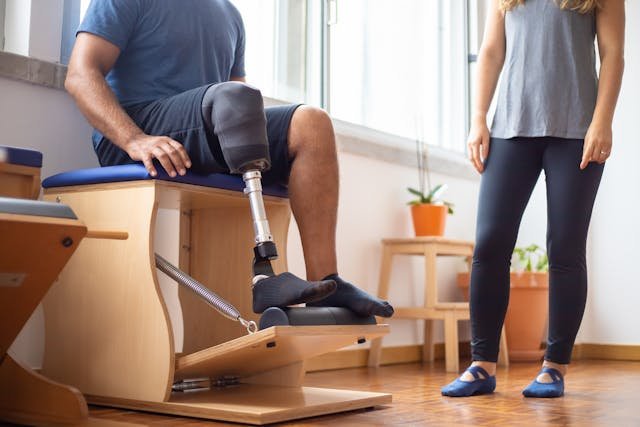Suspension systems are one of the most important parts of any prosthetic limb. They are responsible for holding the prosthesis firmly in place while allowing it to move naturally with the body. Whether you have a below-knee (transtibial) or above-knee (transfemoral) amputation, the type of suspension system you use plays a big role in your comfort, movement, and confidence throughout the day.
At Robobionics, we’ve worked with hundreds of users across India, and we’ve seen that suspension is not just about the mechanics—it’s about how the prosthetic feels when you walk, stand, sit, or climb stairs. In this article, we explain how suspension systems work, how they differ in transtibial and transfemoral prosthetics, and what to expect when choosing the one that fits your life best.
The Purpose of a Suspension System
A suspension system is what keeps the prosthetic limb securely attached to your residual limb. Without good suspension, even the most advanced prosthetic can feel uncomfortable or unstable.
Holding the Prosthesis in Place

The most basic job of a suspension system is to keep the prosthetic in place during all kinds of movement. Whether you are walking on a flat road, climbing stairs, or getting in and out of a chair, the prosthesis must stay connected to your body. If it moves or shifts too much, it can cause pressure, pain, or even falls.
For below-knee prosthetics, the suspension needs to secure the socket around the calf, just under the knee. Since there is more surface area and muscle in that region, creating a snug and comfortable hold is often simpler. Above-knee prosthetics have less limb to work with and rely more on suction or mechanical support to keep everything steady.
A good suspension system ensures the prosthesis feels like part of your own body. It should move with you, not against you. When the suspension works well, users feel more natural and confident in every step.
Supporting Movement and Control
In addition to securing the limb, the suspension system also plays a big role in movement. When you lift your leg or take a step, the prosthesis must follow smoothly. If the socket and suspension aren’t connected properly, you might feel like the limb is dragging or slipping.
For transtibial users, control is usually easier because the preserved knee helps guide motion. The suspension only needs to manage the foot and lower leg. Transfemoral users depend entirely on the socket and suspension system to stay balanced, as they are missing both the lower leg and the knee.
The more stable the suspension system, the easier it is to learn to walk properly. It reduces the need to overcompensate, saving energy and helping users avoid long-term strain on the back or hips.
Reducing Pressure and Skin Problems
Suspension systems also help with pressure distribution. A poor fit or an unstable system can lead to painful pressure points, skin irritation, or even sores. That’s why choosing the right type—and making regular adjustments—is key to long-term comfort.
Below-knee users generally have more skin surface to distribute weight, which reduces pressure in any single spot. Above-knee users have more muscle and less bony structure in the thigh, which can lead to more challenges with pressure and heat buildup.
At Robobionics, we focus on customizing suspension systems to reduce these risks. Whether it’s using the right liners, adding breathable materials, or adjusting socket shape, we work with users to make sure the system supports both comfort and skin health.
Suspension in Transtibial Prosthetics
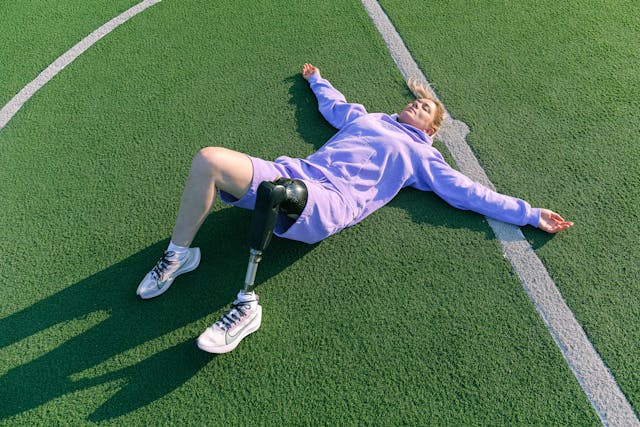
Suspension systems in below-knee prosthetics are generally easier to manage because of the preserved knee joint and more favorable limb shape. But that doesn’t mean one solution fits all—every user still needs a suspension system that matches their daily life and physical needs.
Simpler Control and Movement
One of the advantages of transtibial suspension systems is that they work with the natural knee. This means the leg has better control from the beginning. The suspension system mainly needs to stabilize the socket around the lower leg, which is often a more stable and less complex area to work with.
With proper alignment and fit, transtibial users can walk more naturally and start using their prosthetic sooner after recovery. Because the suspension does not have to handle knee mechanics, it can focus more on comfort, even during active movement.
This also allows for lighter designs. Since the control is shared between the user’s body and the prosthetic, the suspension doesn’t need to be overly tight or mechanical to do its job.
Sleeve and Suction-Based Suspension
Many transtibial users benefit from suction-based systems or suspension sleeves. A silicone or gel liner is often used to create a seal, and a sleeve worn over the socket helps hold everything in place. These systems create a vacuum effect that keeps the socket snug against the skin without needing straps or buckles.
This kind of suspension is especially helpful for users who want more freedom in movement without feeling locked in. It also reduces the number of mechanical parts, which makes maintenance easier.
The seal helps limit movement inside the socket, reducing skin friction. With fewer parts rubbing together, the user experiences less discomfort and better control when walking or standing for long periods.
Pin Lock and Liner Systems
Another common method in below-knee prosthetics is the pin-lock system. In this setup, the user wears a liner with a locking pin at the end. When the limb is inserted into the socket, the pin connects to a mechanical lock inside, holding the prosthesis in place.
Pin locks give users a very secure connection and can be reassuring for those who are very active or concerned about the limb loosening. However, the setup requires careful alignment. If the pin doesn’t click into place smoothly, it can create uneven pressure or discomfort.
These systems are reliable and easy to use once the user is comfortable with the process. At Robobionics, we guide each user during their fittings to ensure they understand how the suspension works and how to adjust it if needed.
Suspension in Transfemoral Prosthetics
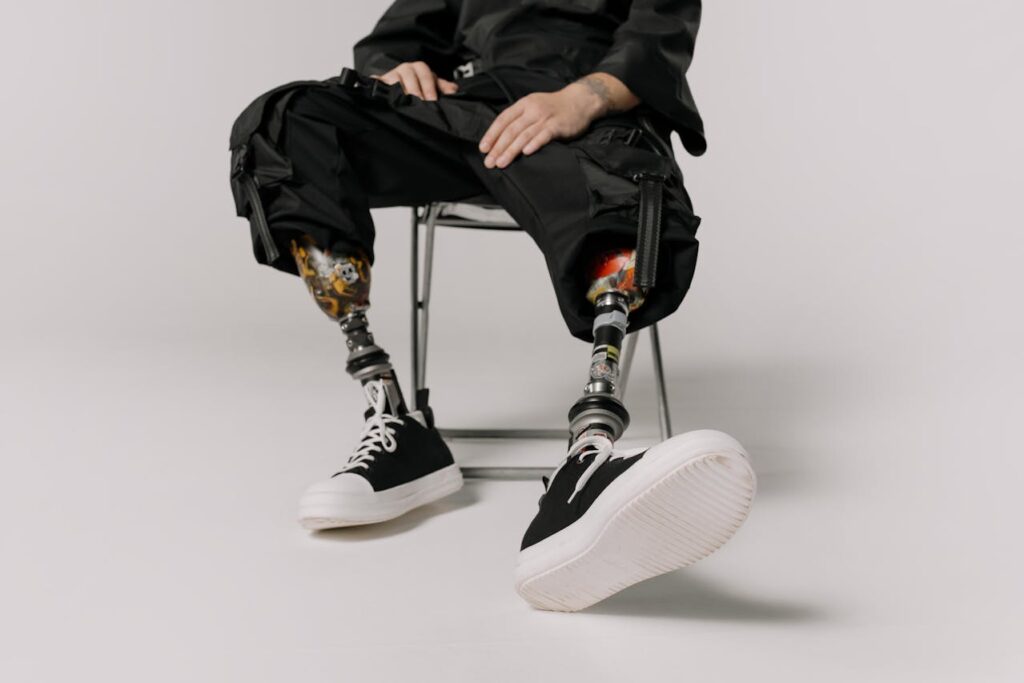
Suspension systems in above-knee prosthetics have a more complex job. Not only do they need to hold the socket in place, but they also have to help control the movement of the prosthetic knee and keep the entire limb aligned during walking.
Handling a Higher Load
Above-knee suspension systems must carry and stabilize more weight than below-knee ones. Since the entire lower leg and knee are missing, the prosthesis is heavier, and there’s less surface area for the socket to grip. This means the suspension system has to work harder to keep everything secure.
Instead of relying on muscle or bone for grip, transfemoral sockets often depend on suction, belts, or vacuum systems to stay connected to the user’s thigh. These systems create strong support but can feel tight or warm if not fitted properly.
The design must balance comfort with control. If the system is too loose, it causes instability. If it’s too tight, it affects blood flow or causes pain. That’s why above-knee users benefit from detailed fittings and frequent adjustments in the early stages.
Suction Suspension with Valve Systems
One of the most common systems used in transfemoral prosthetics is a suction suspension with a valve. The user wears a liner that fits snugly over the thigh. When the limb is inserted into the socket, air is pushed out through a one-way valve, creating a seal that keeps the prosthesis attached by suction.
This method provides excellent stability for everyday walking and allows a smoother gait. It also reduces pistoning, which is the up-and-down motion of the limb inside the socket. With less movement inside the prosthesis, walking feels more natural and safe.
However, suction systems require careful donning techniques and regular skin checks. Any air leakage or improper seal can cause the limb to feel loose or uncomfortable during movement. Robobionics offers training and ongoing support to make sure the seal is maintained and adjusted correctly.
Elevated Vacuum Suspension
For users who need a more advanced system, elevated vacuum suspension offers even better control. In this setup, a small pump actively removes air from the socket, maintaining a consistent vacuum and reducing limb movement. This technology is helpful for users who walk a lot or who have sensitive skin.
Elevated vacuum systems offer benefits like better circulation, reduced swelling, and more responsive movement. However, they are more expensive and require power or mechanical components that need regular maintenance.
Transfemoral users benefit greatly from this type of system when comfort and performance are top priorities. Our team at Robobionics helps users determine whether a vacuum suspension system fits their lifestyle and offers proper training on how to use and maintain it.
Choosing the Right Suspension System
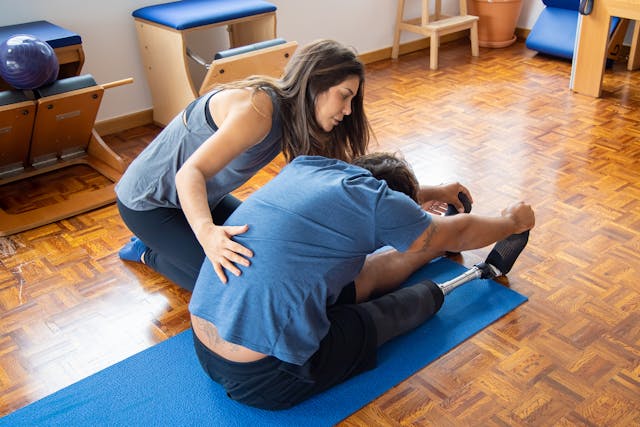
Every suspension system has its own strengths and challenges. The best system is the one that fits your body, lifestyle, and activity level while keeping you comfortable and secure.
Matching Suspension to Daily Activities
People who are very active may need a more secure suspension system that doesn’t shift or loosen during intense movement. Others who spend most of their time indoors may prefer something lightweight and easy to wear for long hours.
Transtibial users often choose suction sleeves or pin locks based on how much control and flexibility they want. Transfemoral users may prefer vacuum systems or suction with valve suspension for more complex movement and better knee control.
Robobionics takes time to understand your needs before recommending a system. Through our detailed evaluation process and demo sessions, we help you feel how different suspension systems perform in real life.
Adjusting for Body Shape and Limb Length
The shape and length of the residual limb also influence which suspension system works best. Some limbs may be long and narrow, others short and wide. Each shape requires a different strategy to hold the prosthesis comfortably and effectively.
Shorter limbs may have more difficulty with suction systems because there is less area to form a seal. In those cases, belts or additional support straps might be used. Longer limbs may allow for more secure suction or pin systems.
Our team at Robobionics uses 3D scanning and measurement to ensure every socket and suspension system is custom-made. This allows for better comfort, longer wear time, and fewer issues down the line.
Evolving with Time and Experience
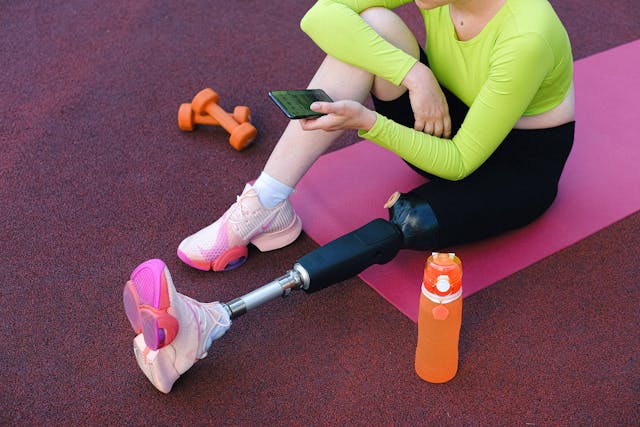
Suspension needs can change over time. As your body changes, you may need to switch systems or adjust the current one. Muscle growth, weight changes, or changes in activity level all affect how the prosthetic fits.
A beginner may start with one type of suspension and later move to something more advanced. Robobionics offers follow-up care and upgrade options to support users as they grow stronger and more active.
What works on day one might not be the best option six months later. Our team helps you track progress and ensures your suspension system continues to work with you—not against you.
Common Challenges with Suspension Systems and How to Overcome Them
Even with the best prosthetics, suspension systems can sometimes cause challenges—especially in the early stages of wearing a new limb. Understanding these issues and knowing how to address them quickly can prevent discomfort, skin damage, and frustration.
Pistoning and Movement Inside the Socket
One of the most common problems users face with suspension systems is pistoning. This is when the residual limb moves up and down inside the socket as you walk or shift weight. Even a small amount of movement can make the prosthesis feel loose and unstable.
Transtibial users may experience pistoning if their suspension sleeve is too loose or the liner is worn out. In transfemoral prosthetics, it often happens when the suction seal breaks or the socket isn’t shaped to hold the limb firmly during motion. This movement not only affects control but also increases friction, which can lead to skin irritation or pressure sores.
The solution starts with a proper fit. At Robobionics, we make adjustments quickly when users report pistoning. Sometimes it’s a matter of switching to a different liner, adding cushioning, or improving the vacuum seal. In other cases, we may reshape the socket or upgrade to a more responsive suspension system to provide a firmer hold.
Discomfort, Redness, or Pressure Points
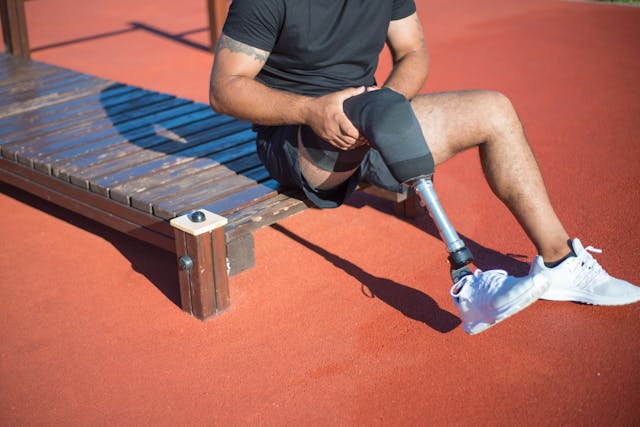
When the suspension system isn’t aligned properly, users may notice pain, redness, or soreness in specific areas of the limb. This can be due to uneven pressure distribution, worn-out liners, or swelling that changes how the limb sits inside the socket.
Transtibial users may experience rubbing near the knee or calf. Transfemoral users often feel pressure around the upper thigh or groin area. These issues can make it difficult to wear the prosthesis for long hours, and if not corrected, they can worsen over time.
Our team advises users to report even mild discomfort early. A small adjustment can prevent bigger problems. We offer regular fit checks and educate users on how to monitor their skin for warning signs. Padding, alignment tweaks, and socket reshaping are all tools we use to relieve pressure and restore comfort.
Difficulty Donning and Doffing the Prosthesis
Another common challenge is putting the prosthetic on (donning) and taking it off (doffing). Some suspension systems—especially those with pin-locks or vacuum seals—require specific techniques that can take time to learn. Improper donning can affect fit and make the limb feel unstable throughout the day.
For transtibial prosthetics, users sometimes struggle with aligning the locking pin correctly. For transfemoral prosthetics, creating an airtight suction seal may be difficult at first, especially for users with limited hand strength or flexibility.
Conclusion
The suspension system is the bridge between your body and your prosthetic. It decides how your prosthetic feels, how it moves, and how much confidence you carry in every step. Whether you’re using a transtibial or transfemoral prosthetic, the right suspension system can turn a good fit into a great one.
At Robobionics, we don’t believe in one-size-fits-all solutions. We offer personalized fittings, real-time demos, and long-term care so that every user finds a suspension system that truly supports their life, their goals, and their movement.
Book a free consultation with Robobionics today and experience the difference a perfectly fitted suspension system can make in your mobility journey.



